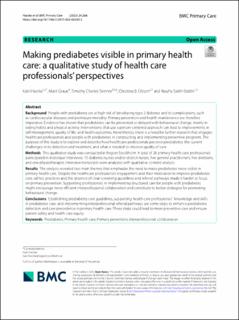| dc.description.abstract | Background:
People with prediabetes are at high risk of developing type 2 diabetes and its complications, such as cardiovascular diseases and premature mortality. Primary prevention and health maintenance are therefore imperative. Evidence has shown that prediabetes can be prevented or delayed with behavioural change, mainly in eating habits and physical activity. Interventions that use a person-centered approach can lead to improvements in self-management, quality of life, and health outcomes. Nevertheless, there is a need for further research that engages healthcare professionals and people with prediabetes in constructing and implementing preventive programs. The purpose of this study is to explore and describe how healthcare professionals perceive prediabetes, the current challenges in its detection and treatment, and what is needed to improve quality of care.
Methods:
This qualitative study was conducted in Region Stockholm. A total of 26 primary health care professionals participated in individual interviews: 15 diabetes nurses and/or district nurses, five general practitioners, five dietitians, and one physiotherapist. Interview transcripts were analyzed with qualitative content analysis.
Results:
The analysis revealed two main themes that emphasize the need to make prediabetes more visible in primary health care. Despite the healthcare professionals’ engagement and their motivation to improve prediabetes care, ad hoc practices and the absence of clear screening guidelines and referral pathways made it harder to focus on primary prevention. Supporting professionals in implementing structured care for people with prediabetes might encourage more efficient interprofessional collaboration and contribute to better strategies for promoting behavioural change.
Conclusions:
Establishing prediabetes care guidelines, supporting health care professionals´ knowledge and skills in prediabetes care, and implementing interprofessional referral pathways are some steps to enhance prediabetes detection and care precedence in primary health care. These steps could lead to more preventive care and ensure patient safety and health care equity. | en_US |

